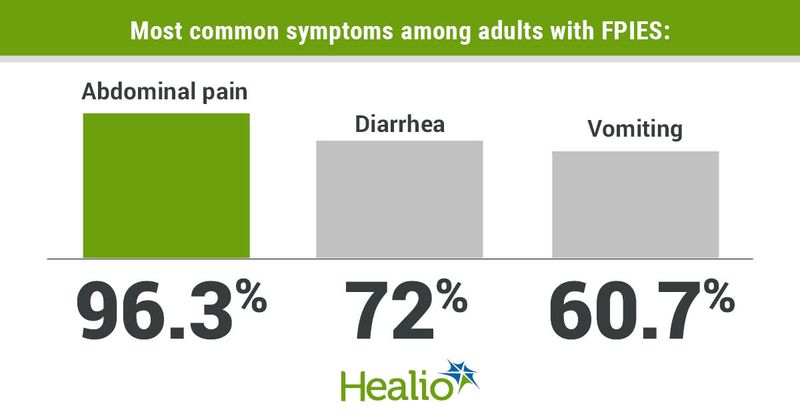Study characterizes food protein-induced enterocolitis syndrome in adults
Click Here to Manage Email Alerts
Adults and children have different experiences with food protein-induced enterocolitis syndrome, although more research is necessary, according to a study published in The Journal of Allergy and Clinical Immunology: In Practice.
Specifically, unlike what has been document in the pediatric population, the adult cohort less frequently experienced vomiting, severe acute episodes and development of tolerance to the offending foods. These clinical differences would support a revision of diagnostic criteria, Purificación González-Delgado, MD, PhD, specialist with the allergy service at Alicante General University Hospital in Alicante, Spain, and colleagues wrote.

Although food protein-induced enterocolitis syndrome (FPIES) — a non-mediated food allergy with symptoms of repetitive vomiting, diarrhea, lethargy, hypotonia, hypothermia, hypotension and metabolic derangements occurring 1 to 4 hours after food intake — is classically described as occurring among children, more cases have been diagnosed in adults, with an estimated prevalence of 0.22% among U.S. adults.
To describe the clinical and demographic characteristic and prognosis of adults with FPIES, the researchers evaluated data of 107 adults (93.5% women; median age of onset, 30 years; interquartile range [IQR], 23-42) diagnosed with FPIES in the allergy section at Alicante General Hospital in a 10-year prospective study. The median time to diagnosis in this group was 4 years (IQR, 2-10), after having experienced a median of eight FPIES episodes (IQR, 5-10).
The most common symptoms included 103 patients (96.3%) with abdominal pain, 77 (72%) with diarrhea and 65 (60.7%) with vomiting, with 44.4% of patients reporting all three symptoms. Also, 15 patients (14%) visited the ED due to possible FPIES symptoms.
Crustaceans (n = 39; 36.4%), fish (n = 35; 32.7%), bivalves (n = 20; 18.7%), cephalopods (n = 19; 17.8%), eggs (n = 15; 14%) and milk (n = 11; 10.3%) were implicated as triggers. All the patients had negative skin prick tests to these foods, with no changes in SPTs during follow-up visits.
Next, the researchers conducted 49 oral food challenges with the suspected triggers for 44 patients, including nine performed to confirm diagnosis following an inconclusive clinical history and 40 to evaluate tolerance to the suspect food following exclusion diets among patients who had been asymptomatic for the previous 2 years.
There were 31 positive OFCs, although one patient who passed the OFC developed vomiting 5 hours later, another developed diarrhea 6 hours later and four developed subsequent FPIES reactions after being exposed to the suspected trigger food after it had been similarly prepared.
Twenty-two of the reactions during the positive OFCs were mild and resolved spontaneously without treatment. Seven participants required IV normal saline, and four received IV ondansetron. All of these patients experienced colicky abdominal pain, 69.7% experienced diarrhea and 51.5% experienced vomiting.
During a median 6.2 years (IQR, 1-10) of follow-up, 10 of the patients achieved tolerance to small amounts of the implicated food, and 18 (16.8%) achieved full tolerance and consumed the food regularly.
The researchers confirmed full tolerance by OFC in 12 patients and by accidental or deliberate intake in six of these patients. The median duration for overcoming FPIES was 3.5 years (IQR, 1-6), with an inverse correlation between disease duration and resolution (P = .04) but not with age of onset. Resolution occurred in more cases of FPIES induced by fish and crustaceans compared with other foods (P = .023).
The researchers found that there was an association between female sex and FPIES. Also, 65.4% of patients had atopy, most commonly rhinitis (64.5%) and asthma (29.9%), with 18.7% reporting a concomitant IgE-mediated allergy to foods other than those causing FPIES.
Compared with the general population, patients with FPIES also had higher rates of irritable bowel syndrome (12.1% vs. 4.6%), eosinophilic esophagitis (4.7% vs. 0.1%), inflammatory bowel disease (3.7% vs. 0.3%) and celiac disease (2.8% vs. 0.7%), with a correlation between a high number of foods implicated in FPIES and irritable bowel syndrome (P = .02).
The researchers noted that children with FPIES experience vomiting in nearly all cases, while diarrhea is relatively infrequent, marking significant clinical differences compared with adults with FPIES.
Children also often present with severe clinical manifestations, but only 15.9% of adults in the study sought medical care, with none requiring intensive care. Plus, the adults in the study all had negative SPTs, whereas up to one-third of children with FPIES show positive IgE to the offending food.
Based on these differences, the researchers recommended a reformulation of diagnostic criteria for adults, although they also said that more studies are necessary to confirm their findings and potential changes.
